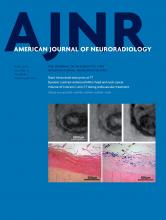Research ArticleAdult Brain
Cortical Cerebral Blood Flow, Oxygen Extraction Fraction, and Metabolic Rate in Patients with Middle Cerebral Artery Stenosis or Acute Stroke
Z. Liu and Y. Li
American Journal of Neuroradiology April 2016, 37 (4) 607-614; DOI: https://doi.org/10.3174/ajnr.A4624
Z. Liu
aFrom the Department of Medical Imaging (Z.L.), First Hospital of Nanchang City, The Third Affiliated Hospital of Nanchang University, Nanchang City, China
Y. Li
bDepartment of Preventive Medicine (Y.L.), Heze Medical College, HeZe, Shandong, China.

REFERENCES
- 1.↵
- Derdeyn CP,
- Videen TO,
- Yundt KD, et al
- 2.↵
- Derdeyn CP,
- Videen TO,
- Simmons NR, et al
- 3.↵
- Derdeyn CP,
- Videen TO,
- Grubb RL Jr., et al
- 4.↵
- Yamauchi H,
- Higashi T,
- Kagawa S, et al
- 5.↵
- Jain V,
- Langham MC,
- Floyd TF, et al
- 6.↵
- Jain V,
- Langham MC,
- Wehrli FW
- 7.↵
- 8.↵
- Langham MC,
- Magland JF,
- Epstein CL, et al
- 9.↵
- 10.↵
- 11.↵
- 12.↵
- 13.↵
- Derdeyn CP,
- Powers WJ,
- Grubb RL Jr., et al
- 14.↵
- Tanaka M,
- Shimosegawa E,
- Kajimoto K, et al
- 15.↵
- 16.↵
- 17.↵
- Mildner T,
- Trampel R,
- Möller HE, et al
- 18.↵
- Binnewijzend MA,
- Kuijer JP,
- Benedictus MR, et al
- 19.↵
- Fujima N,
- Kudo K,
- Terae S, et al
- 20.↵
- Chalela JA,
- Alsop DC,
- Gonzalez-Atavales JB, et al
- 21.↵
- 22.↵
- Ito H,
- Kanno I,
- Kato C, et al
- 23.↵
- Hattori N,
- Bergsneider M,
- Wu HM, et al
- 24.↵
- Coles JP,
- Fryer TD,
- Bradley PG, et al
- 25.↵
- Ibaraki M,
- Miura S,
- Shimosegawa E, et al
- 26.↵
- 27.↵
- Kudomi N,
- Hirano Y,
- Koshino K, et al
- 28.↵
- 29.↵
- 30.↵
- 31.↵
- Guadagno JV,
- Jones PS,
- Fryer TD, et al
- 32.↵
- Sobesky J,
- Zaro Weber O,
- Lehnhardt FG, et al
- 33.↵
- Heiss WD,
- Sobesky J,
- Hesselmann V
- 34.↵
- Derdeyn CP,
- Yundt KD,
- Videen TO, et al
In this issue
American Journal of Neuroradiology
Vol. 37, Issue 4
1 Apr 2016
Advertisement
Z. Liu, Y. Li
Cortical Cerebral Blood Flow, Oxygen Extraction Fraction, and Metabolic Rate in Patients with Middle Cerebral Artery Stenosis or Acute Stroke
American Journal of Neuroradiology Apr 2016, 37 (4) 607-614; DOI: 10.3174/ajnr.A4624
0 Responses
Jump to section
Related Articles
- No related articles found.
Cited By...
- Susceptibility Changes on Preoperative Acetazolamide-Loaded 7T MR Quantitative Susceptibility Mapping Predict Post-Carotid Endarterectomy Cerebral Hyperperfusion
- Lesion evolution and neurodegeneration in RVCL-S: A monogenic microvasculopathy
- Acetazolamide-Loaded Dynamic 7T MR Quantitative Susceptibility Mapping in Major Cerebral Artery Steno-Occlusive Disease: Comparison with PET
- Combining images and anatomical knowledge to improve automated vein segmentation in MRI
- Hematocrit Measurement with R2* and Quantitative Susceptibility Mapping in Postmortem Brain
- Preoperative Cerebral Oxygen Extraction Fraction Imaging Generated from 7T MR Quantitative Susceptibility Mapping Predicts Development of Cerebral Hyperperfusion following Carotid Endarterectomy
- Noninvasive Assessment of Oxygen Extraction Fraction in Chronic Ischemia Using Quantitative Susceptibility Mapping at 7 Tesla
- Association between large artery atherosclerosis and cerebral microbleeds: a systematic review and meta-analysis
This article has not yet been cited by articles in journals that are participating in Crossref Cited-by Linking.
More in this TOC Section
Similar Articles
Advertisement











